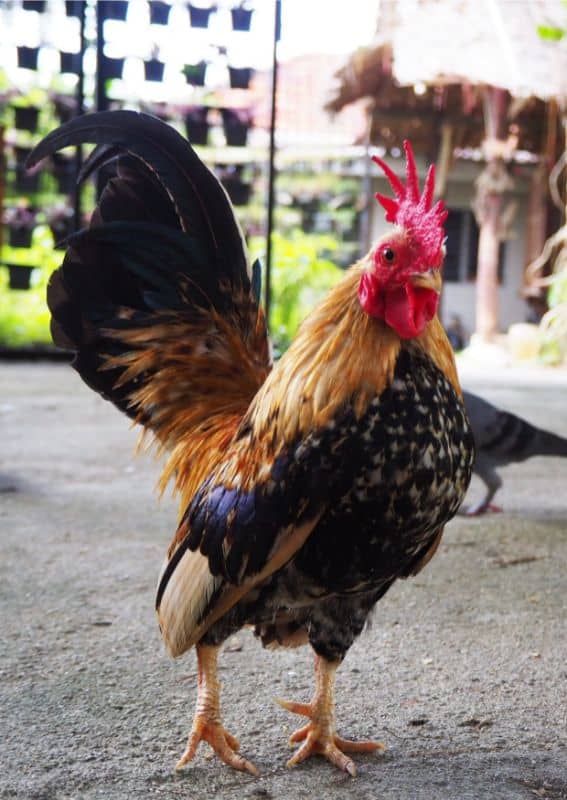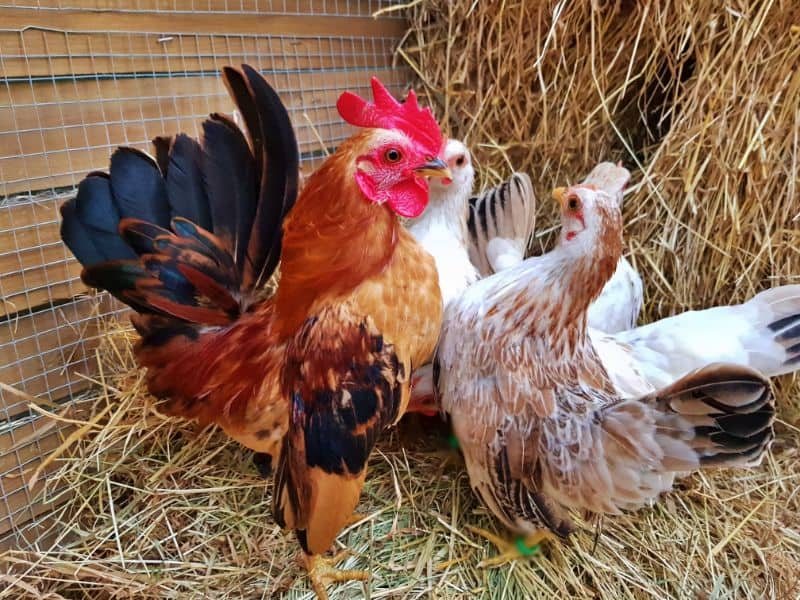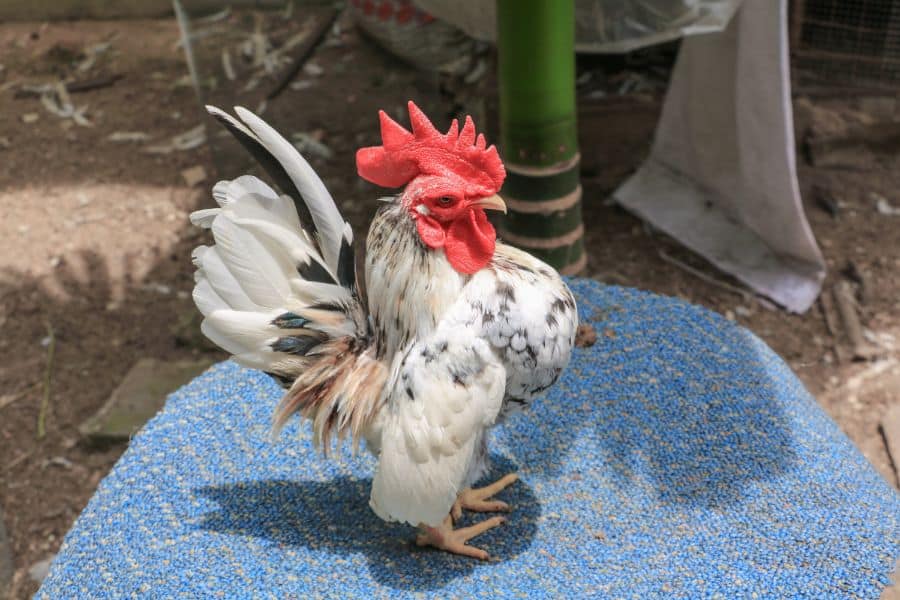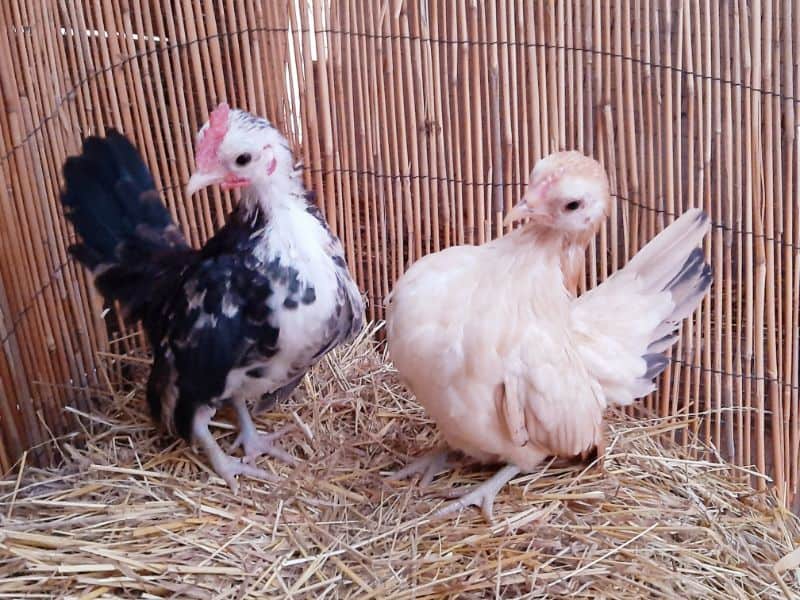Although they are officially known as the smallest chickens in the world, Serama Chickens have more character than almost any other breed.
This modern Serama was developed quite recently, but their ancestors are said to go back to ancient times. The sizes of both the chickens and the eggs mean these birds are usually reared for only one purpose.
Despite being a recent entrant in the world of chickens, the Serama has spread quickly throughout the world. It is now more popular than any other bantam chicken in many countries.
The popularity of the Serama is easy to understand given its unique appearance. They are also easy to raise whether you have a huge backyard or virtually no space for them to roam.
For people aiming to keep chickens for reasons other than meat and eggs, Seramas are an easy choice today. Read on to find out why so many people find the Serama Chicken a great companion.
Serama Chickens Quick Facts
| Names | Serama, Ayam Serama, Malaysian Serama |
| Origin | Kelantan, Malaysia |
| Purpose | Pets and Exhibition |
| Egg Production/Year | 200 |
| Climate | Not Cold Hardy |
| Plumage Color | Over 2500 Variations |
| Weight | Less than 500g (17.64oz) |
| Personality | Very Friendly, Confident |
| Unique Fact | Smallest recognized chicken breed in the world. |
The History of the Serama Chicken
Origins
Serama chickens come from Malaysia, specifically the state of Kelantan. It is said that it was the result of crossbreeding the local bantams with bantam chickens from Japan.
There are some accounts that state the modern Serama chicken was derived from an ancient flock of small chickens that were gifted to a local sultan by the Thai King.
The popularity of small chickens in Malaysia is not new, and they’ve been kept as pets for a long time. These pet chickens are usually referred to by names such as:
- Ayam Katik – Pygmy chickens
- Ayam Cantik – Pretty chickens
The Modern Serama
The Serama chicken that has gained popularity in recent times is said to have been developed within the past 50 years. The breed was publicly exhibited for the first time in 1990.
Wee Yean Een, a man from Kelantan, is credited with developing the Modern Serama chicken. He chose the name as a tribute to King Raja Sri Rama, who was characterized as being majestic, beautiful, and regal.
The Serama chicken was imported into the US for the first time in 2001 by Jerry Schexnayder. He is said to have originally imported 30 roosters and 105 hens and that the birds were handpicked from all over Malaysia for the sake of genetic diversity.
In the UK, Seramas were initially imported in 2004. In the same year, Seramas in Malaysia were culled in large numbers, over 50,000, due to the outbreak of the Asian bird flu epidemic.
In the rest of Europe, Seramas remain rare today despite their increased popularity in France and other countries. This has created a lucrative market for Serama Chicken breeders in Malaysia.
The Appearance of Serama Chickens
Because of their appearance, Serama chickens have been described in lofty terms like:
- Regal
- Confident
- Brave warriors
- Archangel chickens, etc.
Almost every part of the Serama has some characteristic that contributes to the uniqueness of its overall shape. The Malaysian type of Serama will usually have the characteristics listed below.
Head: Seramas have single combs that range from small to medium size with at least five sections and with no folds. The head is small and held some ways back, behind the feet.
Body: Seramas carry their full breasts high and forward creating an elliptical shape that tapers towards the back when the bird is observed from above. Their bodies are also well-muscled.
Wings: Compared to the bird’s body, the wings should be large and kept vertical so they should be just above the ground, almost completely hiding the feet. The Serama’s shoulders should be high.
Tail: Ideally, there should be no space between the Serama’s tail and its body. The tail should be full, lifted high, and kept close to the body with spear-like sickle feathers.
Feet and Legs: Seramas must have strong legs with medium-length thighs and medium-to-long legs. The legs should have enough space between them to allow the body to be fuller and more muscular.
Size of Serama Chickens
Serama Chickens are the smallest recognized breed of all chickens. Most Seramas will weigh less than 500 grams or 18 ounces.
Some Seramas bred in Malaysia are even smaller, weighing less than 250 grams or 8.8 ounces.
Malaysian vs Other Seramas
Thanks to differences in breeding ideologies, Seramas bred outside Malaysia have turned out with certain differences in appearance.
For example, in Malaysia, Seramas are not color bred, a practice that is more common in other regions. On the other hand, in the USA, only the white American Serama is accepted for showing by the American Poultry Association.
The American Bantam Association was accepting black and exchequer colors in addition to white as of 2019.
There are also no written standards for the Serama in Malaysia although there is a guide on how judging and scoring is done during competitions.
In America and some parts of Europe, Seramas with silkie feathers are not unusual. Seramas with such feathers are not recognized in Malaysia even though the gene is said to have been in some of the birds imported from Malaysia.
Other feather mutations that have been observed in Seramas include:
- Frizzled feathers
- Rumpless i.e., stunted tail
- Booted i.e., feathers on their feet and shanks.
When selecting a bird for showing, it’s a good idea to first read up on the guidelines and standards of your region.
Serama Chickens’ Purpose
Ornamental Seramas
Throughout the world, Seramas are mainly kept as ornamental birds. This means they can either be kept as pets or reared to be show birds.
In their native Malaysia, pageants for Serama Chickens are serious business, and their owners like to regard them as warriors. In some competitions or beauty contests, a champion Serama can fetch the owner as much as $10,000.
Beyond the world of exhibitions, many Malaysians keep Serama chickens as pets, some even describing them as part of their families.
Can Seramas be Kept for Meat or Eggs
Although some records state that Serama hens can lay more than 200 eggs in a year, this is not a common reason for rearing these chickens.
Like other bantam breeds, the eggs from Seramas are significantly smaller than those from regular-sized chickens. It’s not uncommon to have Serama eggs that only weigh an ounce.
The size problem also extends to the use of Seramas for meat because they are too small to make a substantial meal. However, it has been noted that in some Malaysian villages, people eat Seramas believing they have aphrodisiac properties or to treat asthma.
Rearing Serama Chickens
Housing and Environment
Seramas may be highly valued show birds, but their housing needs are modest. Thanks to their small sizes, you can even get away with keeping your pet Serama in a regular birdcage.
Regardless of how you house them, you should keep the following factors under consideration:
- Seramas are small birds and are not aggressive. This may make them more vulnerable to some predators.
- Ensure your Seramas’ shelter is free from moisture and drafts.
- Your Seramas should be housed in a location that doesn’t get too cold. Ideally, you should keep your Seramas in an environment that is at least 15°C to keep them in good health especially if they are yet to acclimatize.
- Although Seramas can live in a relatively small space, you shouldn’t limit them to the smallest available cage. Ensure they have at least 3 by 2 feet of space and preferably more.
- To keep your chickens engaged in regular chicken activities, they should have several levels in their cages, perches, toys, treats, and even a dust bath.
- Keeping Seramas indoors is possible even in an apartment. The crows of the roosters are much quieter than those of regular chickens.
- If kept indoors the toenails of Seramas should be clipped regularly to lower the risk of them getting caught in carpeting.
Diet
Another good thing about Seramas is that due to their small size, they don’t consume a lot of food. Additionally, they don’t require any special food as they do quite okay on regular chicken feed.
The one thing you should note is that feed in the form of pellets can be too large for Seramas to eat. Many Serama owners swear by crumbles or mash.
For Seramas under 3 weeks old, the crumbles may have to be ground to a finer size. They should also have plenty of drinking water available throughout.
Temperament
Seramas have a temperament that makes them well-suited to be pets. They show no aggression towards people and like to be handled.
Serama owners have described how their birds will come and perch on their legs when they sit down. Despite their lack of aggression, they have a stance that is both confident and authoritative.
Seramas that are meant to be exhibited are trained to pose on tabletops. They walk in a manner that exudes pride and know how to pull their heads back to showcase their full chests.
Some Seramas make head and neck movements similar to those of pigeons.
Lifespan
A life span of 7 years is normal for Serama Chickens. However, don’t be surprised if yours keeps going until the age of 10.
Breeding Serama Chickens
The original importer of Serama chickens into North America, Schexnayder allegedly said that if you hatched 12 Serama eggs, you’d end up with chicks of 12 different colors. This is one of many challenges in breeding Serama chickens.
It is said that there are more than 2500 recorded color variations of this breed even though some organizations only recognize a handful.
In their country of origin, Seramas were not bred to attain specific colors hence the wide color gamut of the offspring today.
Breeding top-quality Seramas is challenging due to the difficulty in finding good quality brood stock. Many breeders aim to breed from Seramas that have won competitions in the past as these are likely to fetch higher prices.
How Much is a Serama Chicken?
Buying a Serama chicken can cost you anywhere from less than a hundred dollars to thousands of dollars for a champion show bird.
Organizations such as the Serama Council of North America and the Serama Club of Great Britain have been successful in popularizing this breed outside of Malaysia. Such organizations are present in many other countries, especially in Europe.
This surge in popularity means that Malaysian breeders must contend with interest from all over the world including countries like Mexico and Brazil. Competition between breeders is also intense and half a point can be the difference between winning and losing.
Thanks to the high breeding standards coupled with high demand, eggs from a champion couple can go for as much as $32, and eggs from certain bloodlines cost even more.
As for the chickens, although they can be bought at relatively low prices too, show quality birds command hundreds of dollars. A prize-winning bird can easily go for thousands of dollars, and this has created a lucrative market for some.
Read More:
Final Thoughts
Serama chickens have been around for less than 50 years, but they have quickly taken on a larger-than-life persona, attracting interest from all over the world.
The appearance of Seramas is unlike that of any other chicken. When posing, these birds will seem to almost stand upright, their tails held high, and their rounded chests sticking out in an impressive display.
These birds are almost exclusively kept for ornamental purposes and make great pets as they like to interact with people. The housing and dietary demands of Seramas are also simple.
The popularity of shows and pageants dedicated to Seramas has made them immensely valuable and some will cost you thousands of dollars. If you’ve ever thought of getting a chicken only for exhibition or as a pet, Seramas should most certainly be on your list.




